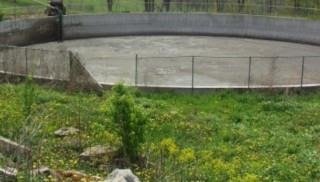By ROBERT MEINEN
Injuries and fatalities occur in confined space manure storages that are enclosed, such as beneath animal quarters, or below-ground reception and pump out pits, and in non-enclosed storages, such as earthen, lined and concrete manure pits, ponds and above ground tanks.

In the case of open-air manure storage pits, ponds and tanks, some hazards can include:
- A thick liquid and floating crust that make swimming, buoyancy or even moving around very difficult.
- Steep and slippery slopes and straight sides that can make getting out of manure storages difficult or impossible.
- Localized layers of hazardous gases existing above manure surfaces, especially on hot, humid days with little to no breeze.
- A speeding up of manure gas release from movement, agitation, removal, or addition of manure to a storage pit, pond or tank.
- Not having sufficient oxygen to breathe if a person is 'treading' in manure because of an inability to get out.
- Not being able to see into depths of manure like you can with clear water.
- A slow response time for adequate emergency actions because of site isolation and remoteness.
Safety guidelines to follow
- Make sure everyone that needs to be near manure storage structures understand the hazards that exist, including the effects that the various gases have on them.
- Make sure the open air manure storage has a fence installed around the perimeter and access gates are locked to keep unauthorized personnel from entering the area. Ladders for climbing to the viewing platform on above ground tanks should be padlocked or kept 8 feet off the ground.
- The open air storage should have manure drowning hazard signs and no trespassing signs on all sides of the storage.
- If you must go into the fenced area of the open manure storage, wearing a safety harness with life line attached to a safely located solid object or anchor will enhance your chances of rescue.
- Never work alone. The second person's role is to summon help in an emergency and assist with rescue without entering the storage.
- Rescue equipment, such as a flotation devices and lifelines, should be attached to every manure pump.
- Move slowly around manure storages as the ground can sometimes be uneven and may cause a person to trip or stumble.
- Bystanders and non essential workers should stay away from pump out or other accessible areas.
- There should be no horseplay near the open manure pit or pumping equipment.
- Explosive gas may be lurking near where agitation or pumping is occurring. No smoking, open flames or sparks should be allowed. If equipment malfunctions during agitating or pumping of the manure, shut all equipment off and remove it from the storage before servicing or repairing.
- If you feel unsure or uncomfortable with what you are getting ready to do near the open manure pit, step back, contact someone and review the situation before proceeding.
- Be prepared to call 911 if an emergency happens. Being prepared means accurately describing the incident, number of victims, and giving specific directions to the site of the emergency.
Source : psu.edu